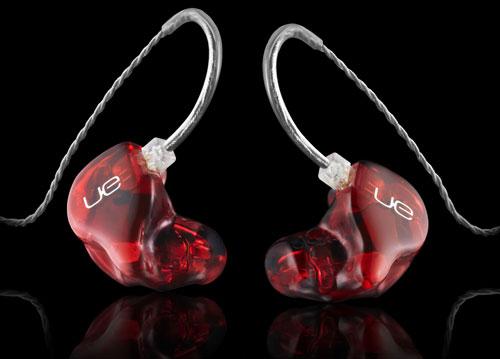Review: Ultimate Ears UE 18 Pro Earphones

Key Features |
| $1350 Ultimateears.com |
| • 4-way design with six proprietary balanced armature drivers in each earpiece • Dual armatures for bass, midrange, and high frequencies + Replaceable low-crosstalk cable • Custom-fit design molded to the user's ear canal for -26 dB passive noise isolation • Frequency Response: 20 Hz to 18,000 Hz • Efficiency: 115.6 dB @ 1mW • Impedance: 21 ohms @ 1kHz • Noise Isolation: -26 dB • Input Plug: 1/8-inch (3.5 mm) gold plate |
Ultimate Ears started out in the rock music industry with the noble mission of helping performing musicians to preserve their hearing. The idea was simple: in place of loud stage monitors, provide each band member with a pair of small, acoustically isolating earphones that could be dialed up to a safe volume during the show.
Not surprisingly, the need for compact size pushed UE toward armature drivers - little cans that emit sound when the air inside is pressurized by a diaphragm. This led in 2007 to the introduction of the UE 11 Pro, a custom-fit earphone whose concept seemed as outrageous as its $1,150 price tag. Though other manufacturers were also using armatures in their miniature phones, UE had managed to create a 3-way design with four drivers in each earpiece, a relative mountain of hardware inside a casing with a face not much bigger than a nickel. There was one driver each for the midrange and highs, and two dedicated to the bass, making the UE 11 the first in-ear monitor with its own dedicated subwoofer.
Though I was initially skeptical, I found the UE 11 Pro to be light years ahead of any headphone I'd tried in terms of overall tonal balance, imaging, musical detail, and sheer brute-force dynamics. (See review here). It was so good that I instantly cast aside all of the high-end noise-canceling cans I'd been toting around and began listening exclusively with those tiny wonders that fit in the palm of my hand. And there it remained as my reference - until now.
The UE 18 Pro reviewed here recently joined Ultimate's line-up as the new flagship. It costs $1,350 plus an extra $100 or so for a visit to an audiologist (more about that in a minute). Given the UE 11's stellar performance and advanced design, it's worth noting that the 18 Pro is an evolutionary step up for UE rather than a giant leap. But Paul Manfrini, UE's director of product development, explained that the company felt there was room for improvement in the UE 11's sonics. Among the areas of focus were a mild obscuring of the midrange that was affecting the quality of some vocals, and a slight elevation in the bass that was pleasing for many listeners but not accurate. And they wanted to eke out just a little more high frequency extension to give the earphones a bit more range and openness.
These limitations were addressed by going from a 3-way to a 4-way design and using - count 'em, now - six individual armatures to reproduce the full audio spectrum. There are two in the bass, two in the midrange, and two at the top for the highs. A passive crossover on a miniscule printed circuit card breaks up the signal, and there are a pair of plastic tubes (fitted with acoustic filters) that route the sound from the midrange and high frequency transducers to separate openings at the business end of the earpiece. In what amounts to another update from the UE 11, the output from the bass drivers is also routed directly to the ear and no longer has to share a tube with the midrange drivers. This new "triple-bore" design helps to further enhance clarity.
All of these parts are ensconced in a hard plastic translucent shell. Build quality is very solid, and the cable, the most delicate part of the earphone, is replaceable if it ever fails. If you don't lose 'em, these phones should last a long time. As a final touch, UE upgraded the cable on the UE 18 to a new design that is said to reduce the channel crosstalk typical of most headphones.













































